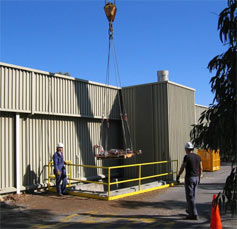
Handy Links
SLAC News Center
SLAC Today
- Subscribe
- Archives: Feb 2006-May 20, 2011
- Archives: May 23, 2011 and later
- Submit Feedback or Story Ideas
- About SLAC Today
SLAC News
Lab News
- Interactions
- Lightsources.org
- ILC NewsLine
- Int'l Science Grid This Week
- Fermilab Today
- Berkeley Lab News
- @brookhaven TODAY
- DOE Pulse
- CERN Courier
- DESY inForm
- US / LHC
SLAC Links
- Emergency
- Safety
- Policy Repository
- Site Entry Form

- Site Maps
- M & O Review
- Computing Status & Calendar
- SLAC Colloquium
- SLACspeak
- SLACspace
- SLAC Logo
- Café Menu
- Flea Market
- Web E-mail
- Marguerite Shuttle
- Discount Commuter Passes
-
Award Reporting Form
- SPIRES
- SciDoc
- Activity Groups
- Library
Stanford
Around the Bay
SLAC Proposes New Facilities for Accelerator and Detector Research
 SLAC has always been at the forefront of developing new accelerators, and doesn't intend to stop now. At a Department of Energy review onsite February 19 and 20, the Particle Physics and Astrophysics directorate will present its case for building facilities to pursue new concepts for future accelerators and detectors.
SLAC has always been at the forefront of developing new accelerators, and doesn't intend to stop now. At a Department of Energy review onsite February 19 and 20, the Particle Physics and Astrophysics directorate will present its case for building facilities to pursue new concepts for future accelerators and detectors.
The proposal, called FACETóFacilities for Accelerator Science and Experimental Test Beams at SLACówould be one of two test beam facilities in North America, and the only program in the world with the capabilities to study high-gradient plasma wakefield acceleration.
"This facility will enable us to study new acceleration techniques that could transform the way particles are accelerated with possible application to future linear colliders and compact radiation sources," said Tor Raubenheimer, head of Accelerator Research.
FACET would restore some of the capabilities lost when the Final Focus Test Beam (FFTB) facility project was discontinued to clear way for the Linac Coherent Light Source, and would reuse magnets from the FFTB and the Stanford Linear Collider.
The proposal calls for using the first two-thirds of the linac to bring electron and positron beams to new experimental areas in Sector 20 of the linac, just upstream of the LCLS injector. In addition, the last 200 meters of the PEP-II injection line would be re-routed to bring a lower energy electron beam from the linac into End Station A.
The Sector 20 facility would focus on applying high-power electron and positron beams to advanced accelerator research, including plasma wakefield studies. In one of the early experiments, researchers will split the compressed electron bunches into two pieces, using the first bunch to ionize and drive the plasma that will in turn accelerate the trailing or "witness bunch." They will also be able to study acceleration of positively charged positron beams, which would interact differently with the negatively charged plasma. The goal is to accelerate particles in a much shorter distance, making giant accelerators a thing of the past.
The End Station A facility would conduct a variety of detector studies for a future linear collider, for upgrades to the Large Hadron Collider, and testing new detector systems.
If the proposal goes forward, funding and construction could begin as early as fiscal year 2009, with the Sector 20 portion of the project ready in 2010 and the End Station A portion ready in 2011.
—Heather Rock Woods, SLAC Today, February 13, 2008
Above image: The access shaft at Sector 19 would be used to lower large components for the FACET project into the accelerator tunnel.